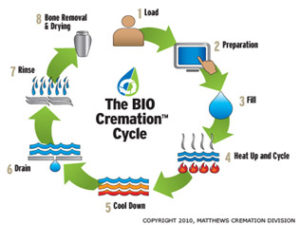
For most Americans there have long been only two obvious choices: burial or cremation. But a third option is becoming available in more states for the disposal of human remains through the method: a liquefaction process, chemically known as alkaline hydrolysis.
A machine uses a chemical bath to dissolve protein, blood and fat, leaving only a coffee-colored liquid, powdery bone and any metal implants, like dental fillings. The process, which was patented in 1888, has been used for disposing of human cadavers and pets but is being requested by more families.
Some people are motivated to use this process, known as “Green Cremation, ” “Fire to Water, ” and “Aqua Green” (among other names), for environmental reasons or for cost savings, as cemeteries fill up. Others find the process more comforting than cremation–more gentle and quiet than through the fire of cremation.
You can read more about it in this New York Times article from October 19, 2017:
https://www.nytimes.com/2017/10/19/business/flameless-cremation.html
They explain that “About 65 percent of the human body is already water, while another 20 percent or so is protein, including blood, muscle and collagen, which is found in tissue and bone. The alkali breaks down the body’s proteins and fats. The machine produces sterile brown effluent made up of minerals, salts, amino acids, soap and water, as well as weakened bones that can be crushed into an ash, and any metal in the body.”